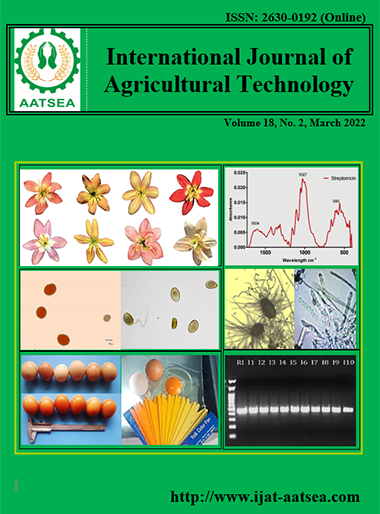Effect of drying methods during priming on quality and longevity of rice seeds
Main Article Content
Abstract
The best suitable drying method for primed Khao Dawk Mali 105 rice seeds was used a hot air oven at 30 °C for 36 h and stored them in the uncontrolled environment. There was resulted to be lowest moisture, highest germination percentage and germination index for primed seeds. This method can keep the moisture in rice seeds low, reduce the process of decaying and extend the longevity and quality of primed rice seeds
Article Details

This work is licensed under a Creative Commons Attribution-NonCommercial-NoDerivatives 4.0 International License.
References
Chapman, G. W. and Robertson, J. A. (1987). Moisture content relative humidity equilibrium of high-oil and confectionery type sunflower seed. Journal of Stored Products Research, 23:115-118.
Coradi, P. C., Lima, R. E., Padia, C. L., Alves, C. Z., Teodoro, P. E. and Carina, S. C. A. (2020). Soybean seed storage packaging technologies and conditions of storage environment. Journal of Stored Products Research, 89:101-109.
Department of International Trade Promotion, Ministry of Commerce (2018). Thailand export rice. Retrieved from: http://www.ditp.go.th/ditp_web61/. (in Thai).
Duangpatra, J. (1986). Seed moisture test. In: Seed testing and analysis, Bangkok, Kaset book group, pp.15-21. (in Thai).
Fakthongphan, J. (2016). Seed priming for unfavorable condition tolerance. Journal of Agricultural Research and Extension, 34:196-210. (in Thai).
Hlyka, I. and Robinson, A. D. (1954). Moisture in grains and its measurement. In: Storage of cereal grains and their products, Minnesota, Woodhead Publishing, pp. 1-45.
ISTA. (2019). International Rules for Seed Testing, Edition 2010. International Seed Testing Association. Zurich, Switzerland.McDonald, M.B. and Kwong, F.Y. 2005. Flower Seed Biology and Technology. CABI Publishing, Wallingford, UK.
James, E. (1967). Methods of Preserving Seeds. In: Preservation of seed stocks, Fort Collins, pp. 87-106.
Jiemjan, J. and Thiphinkong, D. (2019). Effect of seed priming by pig placenta bio-extract on rice seed quality. (special problems). King Mongkut’s Institute of Technology Ladkrabang, Thailand. (in Thai).
Kulnoi, S. and Boondauylan, S. (2020). Study of suitable seed storage methods on sunflower seed quality. (special problems). King Mongkut’s Institute of Technology Ladkrabang, Thailand. (in Thai)
McDonald, M. B. (2000). Seed priming. In: Seed Technology and its Biological Basis (Black M. and Bewley J. D.), England, Sheffield Academic Press, pp.287-316.
Parawisut, W., Ariyapruek, D., Kanjana, P. and Thongsean, S. (2005). Effect of driers on rice seed quality. Department of Agriculture, pp.1-51. (in Thai).
Ruchiracak, M., Seephueak, P. and Koetnoon, P. (2010). Bioextract of pigcenta fermentation as the rice seed quality enhancer. Proceedings of the National Seed Conference, 7:118-124. (in Thai).
Samphunphuang, C., Pipithsangchan, K., Wongchang, P., Songserm, A. and Dachakumpoo, S. (2016). Influence of seed moisture content and storage temperature to safflower seeds germination. Thai Agricultural Research Journal, 34:65-75. (in Thai).
Santipracha, K. (1987). The improvement of seed germination. Songklanakarin Journal of Plant Science, 9:401-408. (in Thai)
Schwember, A. R. and Bradford, K. J. (2005). Drying rates following priming affect temperature sensitivity of germination and longevity of lettuce seed. HortScience, 40:778-781.
Siri, B. (2015). Seed enhancement by seed priming. In: Seed conditioning and Seed enhancements, Khon Kaen, Klung nana, pp. 239. (in Thai)


